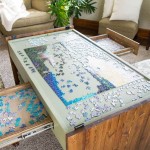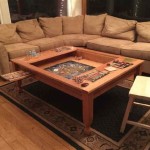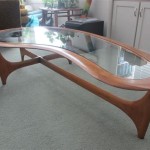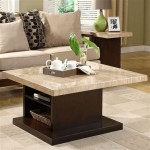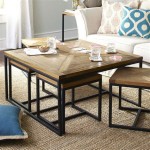Small End Table Ideas: Maximizing Functionality in Limited Spaces
End tables are essential pieces of furniture that provide surface space for lamps, drinks, books, and decorative items. In smaller living spaces, selecting the right end table is crucial for optimizing functionality without overwhelming the room. Small end tables offer a practical solution, providing the necessary surface area while maintaining a sense of spaciousness. This article explores various small end table ideas, focusing on design considerations, material options, and innovative features that enhance the utility of these compact furnishings.
Space-Saving Design Principles
The core principle behind selecting a small end table is maximizing functionality within a limited footprint. Several design approaches contribute to this goal. Round end tables, for instance, can often fit more easily into tight corners or alongside curved furniture, minimizing sharp edges that might impede traffic flow. Square or rectangular tables, when chosen strategically, can be placed flush against walls or between furniture pieces to utilize every inch of available space.
Height is another crucial factor. End tables should ideally be at the same height as, or slightly lower than, the arm of the adjacent sofa or chair. This ergonomic consideration ensures that items placed on the table are easily accessible. A table that is too high or too low can be uncomfortable and visually disrupt the harmony of the room.
Consideration should also be given to the visual weight of the end table. Opting for designs with open bases or slender legs creates a sense of lightness, preventing the table from appearing bulky or imposing. Solid, heavy end tables can visually shrink a small space, while more airy designs contribute to an open and inviting atmosphere.
Foldable or nesting end tables offer exceptional flexibility. These options can be easily stored away when not needed, freeing up valuable floor space. Nesting tables provide multiple surfaces that can be pulled out for entertaining or rearranged to suit different needs. These adaptable designs are particularly well-suited for apartments and other compact living areas.
When considering the overall aesthetic, it's important to choose a design that complements the existing decor. A minimalist end table can blend seamlessly into a modern setting, while a more ornate design might be appropriate for a traditional space. Consistency in style and color helps to create a cohesive and visually pleasing environment.
Material Selection: Balancing Durability and Aesthetics
The material from which an end table is constructed plays a significant role in its durability, appearance, and overall cost. Wood, metal, glass, and acrylic are among the most common materials, each offering unique advantages and disadvantages.
Wooden end tables provide a classic and versatile option. Solid wood offers exceptional durability and can be refinished or repainted to adapt to changing decor. However, solid wood can be expensive and susceptible to damage from moisture and extreme temperatures. Veneered wood offers a more affordable alternative, providing a similar aesthetic appearance at a lower cost. Particleboard or MDF (medium-density fiberboard) with a wood veneer is another budget-friendly option, but it may not be as durable as solid wood or solid wood veneer.
Metal end tables offer a sleek and contemporary look. Steel and iron are popular choices for their strength and industrial appeal. Metal tables are often powder-coated to protect against rust and scratches. Aluminum is a lighter-weight option that is also resistant to corrosion. Metal end tables can be particularly well-suited for modern or minimalist interiors.
Glass end tables create a sense of openness and lightness. Transparent glass allows light to pass through, making the room feel brighter and more spacious. Tempered glass is a safer option, as it is more resistant to shattering. Glass tables can be paired with metal or wooden frames for added stability and visual interest. However, glass surfaces require regular cleaning to maintain their pristine appearance.
Acrylic end tables offer a modern and versatile alternative to glass. Acrylic is a durable and lightweight material that is available in a variety of colors and shapes. It is also less prone to shattering than glass. Acrylic tables can be a great choice for contemporary or eclectic interiors. However, acrylic surfaces can be susceptible to scratches and may require specialized cleaning products.
The choice of material should be based on a combination of aesthetic preferences, budget considerations, and durability requirements. Consider the level of maintenance required for each material and select an option that aligns with the user's lifestyle and habits.
Innovative Features and Multifunctional Designs
Small end tables can incorporate a variety of innovative features that enhance their functionality and versatility. Storage options, such as drawers, shelves, and hidden compartments, are particularly valuable in small spaces. These features provide a convenient place to store remote controls, books, magazines, and other items, keeping the surface of the table clutter-free.
End tables with built-in charging stations are increasingly popular. These tables typically include USB ports and electrical outlets, allowing the user to charge electronic devices without having to search for a wall outlet. This feature is particularly useful in living rooms and bedrooms, where people often spend time using smartphones, tablets, and laptops.
Adjustable-height end tables offer exceptional flexibility. These tables can be raised or lowered to accommodate different activities, such as working on a laptop or enjoying a meal while sitting on the sofa. Adjustable-height tables are particularly well-suited for small apartments and other spaces where furniture needs to serve multiple purposes.
End tables with built-in lamps provide a convenient two-in-one solution. These tables eliminate the need for a separate floor lamp, saving space and simplifying the room's layout. The lamp can be integrated into the table's design, creating a cohesive and stylish look.
Some end tables feature removable trays, which can be used to serve snacks or drinks. These trays are easy to clean and provide a convenient way to transport items from the kitchen to the living room. End tables with removable trays are particularly useful for entertaining guests.
End tables with integrated magazine racks or book holders are ideal for avid readers. These features provide a convenient place to store books and magazines, keeping them within easy reach. The magazine rack or book holder can be incorporated into the table's design in a variety of ways, from simple slots to more elaborate shelving systems.
When selecting an end table with innovative features, it's important to consider the user's specific needs and preferences. Choose features that will genuinely enhance the table's functionality and make it a valuable addition to the room.
Small end tables are essential for maximizing functionality in limited living spaces. By carefully considering design principles, material options, and innovative features, it is possible to select an end table that is both stylish and practical, contributing to a comfortable and well-organized home environment. The range of available options ensures that there is a suitable small end table for every taste and budget.
:max_bytes(150000):strip_icc()/bitterrootdiy-48367ba16c474e0595b81ae9a6a8c0a3.jpg?strip=all)
21 Diy End Table Plans
:max_bytes(150000):strip_icc()/stump-table-and-buffet-1691-56a262a85f9b58b7d0c99059.jpg?strip=all)
8 Must Try Diy Side Tables

Decorating A Small End Table 5 Challenges And Solutions Stonegable

20 Gorgeous Side And Accent Table Ideas For Your Small Space

Home Decor 101 How To Decorate End Tables

33 Diy End Tables With Funky Fresh Designs

22 Small Table Makeover Ideas Artsy Rule

35 Best Diy Side Table Ideas Plans For

2x4 Modern Farmhouse Diy End Table Tylynn M

Decorating A Small End Table 5 Challenges And Solutions Stonegable
Related Posts



